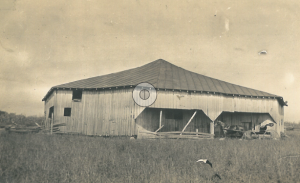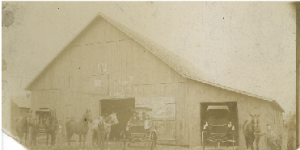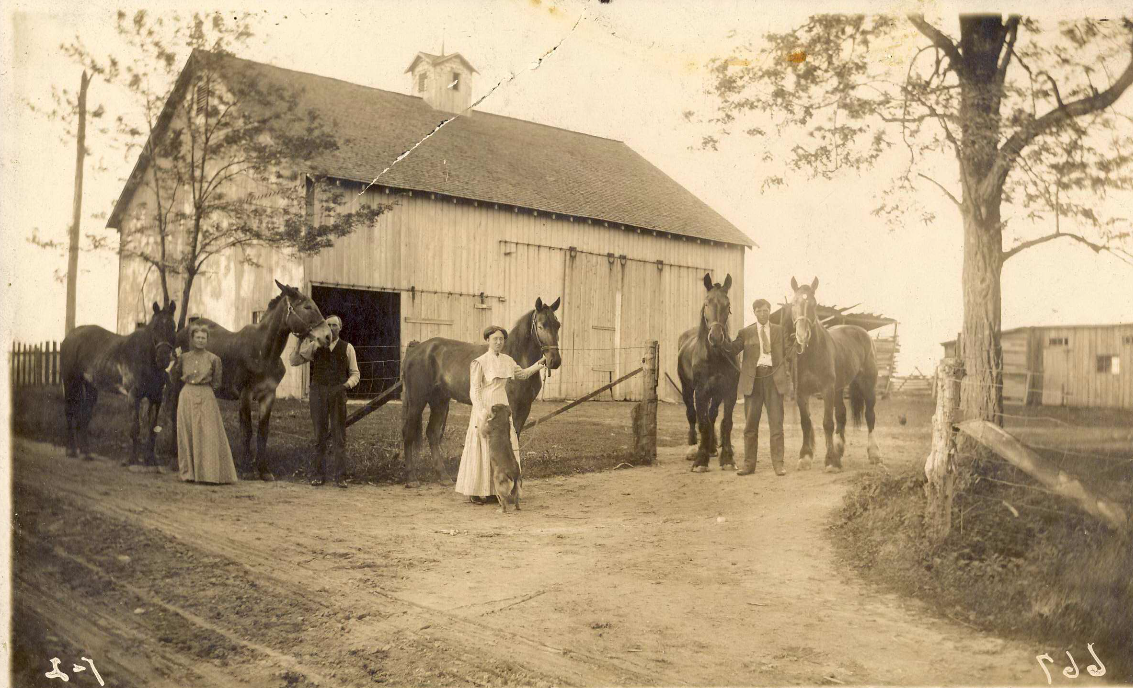Southside Barns Have Stood the Test of Time
Courtesy of Johnson County Historical Society
Driving through Johnson County reveals a variety of beautiful barns in different architectural styles. They were built to last forever, with strong beams and wooden pegs. Meant to be entirely utilitarian, time and weather have softened and altered the barns into nostalgic works of art.
Here are a few from Johnson County history and from modern days. See if you can find these styles today as you travel through Johnson County.
 Traverse Crib Barn
Traverse Crib Barn
The earliest barns were simply “cribs” for storing grain. When several cribs are joined together under one roof and separated by an aisle, the result is the transverse crib barn. When the same barn form is made of dimension or saw-cut lumber, it is called a transverse frame barn.
In a photo from early 20th century, Peter Jacobs and his family sit in a “horseless carriage” in front of their traverse crib barn.
Midwest Three-Portal Barn
The Midwest 3-portal barns have three aisles that extend through the barn, parallel to the roof ridge. Large hay hoods at the top of the gable are typical features of the 3-portal barns which are used for hay storage and for feeding livestock.
The White River Township barn belonging to Charlie and Judy Stewart is a prime example. The three openings are clearly visible.
Dairy Barn
The gambrel roof, roof ventilators and multiple windows are the typical features of dairy barns built in the early 20th century when the dairy industry was booming. Many have attached silos.
This barn is on the grounds of the Masonic Home in Franklin, Indiana.
German Bank Barn
Sometimes called Pennsylvania or Sweitzer barns, the German barns are typically built into an earthen bank and are characterized by their massive size and the cantilevered floor – called a forebay – that extends over the feedlot above the basement level.
Owned by Marvin and Louise Beaman in Franklin Township, this barn was built in the late 1800s.
English Barn
Also called a Yankee or 3-bay threshing barn, the English barn is a common type throughout the county. Its form and function are rooted in the English tradition of barns devoted to grain processing and storage but not originally to house animals. Doors are always located on the broad sides.
John Overstreet was owner of this barn, photographed ca. 1900.
Polygonal and Round Barns
Round barns were promoted by agricultural experiment stations at land-grant colleges as a way of using the same amount of material as a traditional barn to provide more useable space.
This Clark Township hexagonal barn was built around 1854, 30 years before the idea became a fad. It was owned by Taylor Ballard.
Basement Barn
Similar to the German Bank Barn in structure, but with both sides open, the basement barn permitted farmers to increase the usefulness of barns by exposing all or most of the basement story. This provided space for animals while grain processing and storage, as in English barns, occurred above.
Look out for these barn styles as you drive through the Southside.






